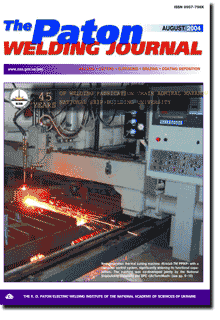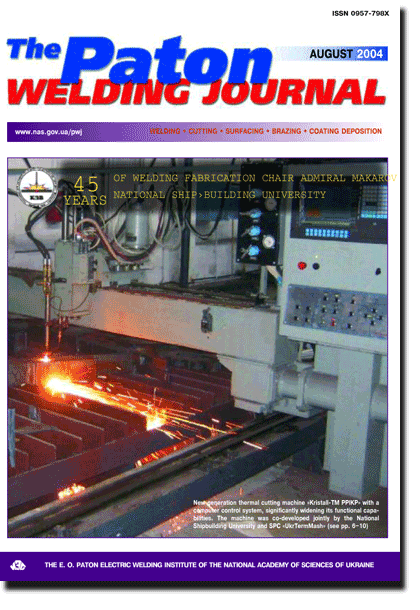

(You are viewing the simplified file contents)
AS = «Automatic Welding» - 6 issues per year;
TPWJ = «PATON WELDING JOURNAL» - 12 issues per year;
SEM = «Electrometallurgy Today» - 4 issues per year;
TDNK = «Technical Diagnostics and Non-Destructive Testing» - 4 issues per year.


| 45 YEARS OF WELDING ENGINEERING CHAIR | |
| Dragan S.V., Kvasnitsky V.V., Romanchuk N.P.,Solonichenko Yu.V. and Goloborodko Zh.G. Welding and cutting processes in shipbuilding of Ukraine | 2 |
| Welding technologies used for the fabrication of ship structures at the shipyards of Ukraine are reviewed. Prospects for improvement of assembly-welding processes in shipbuilding are outlined. | |
| Vereshchago E.N., Kvasnitsky V.F., Romanovsky G.F. and Prosyanov O.F. Development of a highly dynamic machine for thermal cutting | 6 |
| A new approach is considered to construction of the systems of control of electric drives in thermal cutting machines, proceeding from the condition of implementation of the assigned motion trajectories, aimed at expansion of the sphere of their application and improving the cost-effectiveness of their use. | |
| Serbin S.I., Kvasnitsky V.V., Goloborodko Zh.G.,Matvienko M.V. and Buryakov A.V. Modeling of gas phase composition in plasma cutting of ship hull steels | 11 |
| Two plasma-chemical systems, namely air low-temperature and air-vapour plasma, are considered. In keeping with the kinetic diagram, including 258 reactions, the design method was used to determine the composition of the gas phase in weight fractions of the components. | |
| Kvasnitsky V.F. and Markashova L.I. Intensification of the process of diffusion bonding of heat-resistant alloys | 15 |
| It has been established that creep processes at a transient stage used in diffusion bonding of heat-resistant alloys reduce the time of formation of a physical contact between the mating surfaces. Bonding of billets of a heat-resistant alloy in the austenised and aged states, or utilisation of spacers in a structural state differing from that of the base metal, allows intensification of the processes of interaction of the mating surfaces and provides properties of the joints at a level of those of the base metal. | |
| Ermolaev G.V., Labartkava A.V. and Khiznichenko Yu.N. Allowance for plastic strains in computer modeling of stress fields in brazed joints made from dissimilar materials | 19 |
| Using the finite element method, the procedure of modeling fields of natural stresses and strains with allowance for plastic strains has been developed. A good accuracy of the method is shown by comparison of theoretical and experimental values. It was found that the first plastic strains are appeared in the joint at its edges where high tangential txy and normal sx stresses are combined. | |
| Lebedev Yu.M. and Martynenko V.A. Application of a nonconsumable carbon-electrode arc at surface treatment of steels with a low hardenability | 23 |
| Structural transformations in low-carbon steels during carbon-electrode arc surface hardening by heating without melting are considered. The effect of carbon, grain size and initial metal temperature on the conditions of hardening of low-carbon steels is shown. | |
| SCIENTIFIC AND TECHNICAL | |
| Lobanov L.M., Poznyakov V.D. and Mikhoduj O.L. Effect of residual stresses on technological strength of welded joints of high-strength steel 14KhGN2MDAFB | 29 |
| Effect of diffusible hydrogen content and welding heat input on delayed fracture resistance of 14KhGN2MDAFB steel welded joints made by using wire Sv-10KhN2GSMFTYu, has been studied. Relationship has been established between the level of residual stresses and longitudinal and transverse cold crack resistance of the joints in the above steel welded using wires that provide the weld metal with bainitic-martensitic (BM), ferritic-bainitic (FB) and austenitic (A) structures. | |
| Yushchenko K.A., Savchenko V.S., Chervyakov N.O. and Zvyagintseva A.V. Character of formation of hot cracks in welding cast heat-resistant nickel alloys | 34 |
| Mechanisms of formation of hot cracks in HAZ during fusion welding have been studied. It is presumed that heating of the HAZ metal of a heat-resistant alloy during welding causes structural transformations of the strengthening gВ-phase, accompanied by changes in metal volume. Hot cracks are induced by the deformation processes localised in a narrow zone, where the nickel alloy structure remains fully austenitic for a certain period of time. | |
| Savitsky A.M., Savitsky M.M. and Novikova D.P. Influence of welding speed and duration of periodical cooling on structure formation in welded joints of hardening steels in arc welding with thermal cycling | 39 |
| Proceeding from analysis of the relationship between the heating and cooling conditions of welded joints it is shown that the main welding parameters upon which the efficiency of thermal cycling depends, are welding speed and pause duration. These parameters determine the heating rate, number of heating and cooling cycles and thermal cycling interval, which, in turn, determine the kinetics of structural transformations in heating and cooling of a welded joint. | |
| Bondarev A.A., Ternovoj E.G., Shvets V.I., Nazarenko S.V., Rassamakhin B.M. and Tarasov G.V. Structure and properties of thin-sheet EB welded joints in iron-nickel alloy 32NKA | 44 |
| Data on electron beam weldability of iron-nickel alloy 32NKA of the type of Invar are presented. Parameters for welding different types of the joints for the fabrication of thin-walled shell structures have been optimised. Chemical composition, mechanical properties, microstructure, density, hardness and chemical heterogeneity of welded joints have been investigated. X-ray diffraction analysis of the recrystallisation zone has been conducted. Recommendations on the use of electron beam welding for the commercial fabrication of welded structures are given. | |
| BRIEF INFORMATION | |
| Pentegov I.V. Generalization of formula of K.K. Khrenov for determination of temperature of welding arc plasma | 48 |
| Formulae to determine temperature of the welding arc plasma as a function of pressure in the plasma have been derived using the Steenbeck principle of the arc minimum. It is shown that the Khrenov's formula becomes precise at a very high pressure, while at low pressure the formula, defined more precisely, is valid, giving the decrease in temperature and increase in degree of ionisation of plasma with pressure reduction in the arc plasma. | |
| Zhernosekov A.M. Effect of electrode stickout on weld parameters in pulsed-arc welding of steels | 51 |
| Effect of changes in electrode stickout on geometric parameters of welds in pulsed-arc consumable electrode welding was studied. It was found that application of system of automatic stabilization of mean values of arc voltage with an effect on parameters of power source pulses does not allow compensation of change in weld width. System of automatic stabilization of mean values of arc voltage and welding current with a proper effect on parameters of pulses of power source and electrode wire feed speed prevents the decrease in weld width caused by increase in electrode stickout. | |
(You are viewing the simplified file contents)
The cost of subscription/purchase order journals or individual articles
| Journal/Currency | Annual Set | 1 issue printed |
1 issue |
one article |
| AS/UAH | 1800 UAH | 300 UAH | 300 UAH | 150 UAH |
| AS/USD | 192 $ | 32 $ | 26 $ | 16 $ |
| AS/EUR | 180 € | 30 € | 25 € | 15 € |
| TPWJ/UAH | 7200 UAH | 600 UAH | 600 UAH | 280 UAH |
| TPWJ/USD | 384 $ | 32 $ | 26 $ | 16 $ |
| TPWJ/EUR | 360 € | 30 € | 25 € | 15 € |
| SEM/UAH | 1200 UAH | 300 UAH | 300 UAH | 150 UAH |
| SEM/USD | 128 $ | 32 $ | 26 $ | 16 $ |
| SEM/EUR | 120 € | 30 € | 25 € | 15 € |
| TDNK/UAH | 1200 UAH | 300 UAH | 300 UAH | 150 UAH |
| TDNK/USD | 128 $ | 32 $ | 26 $ | 16 $ |
| TDNK/EUR | 120 € | 30 € | 25 € | 15 € |
AS = «Automatic Welding» - 6 issues per year;
TPWJ = «PATON WELDING JOURNAL» - 12 issues per year;
SEM = «Electrometallurgy Today» - 4 issues per year;
TDNK = «Technical Diagnostics and Non-Destructive Testing» - 4 issues per year.

